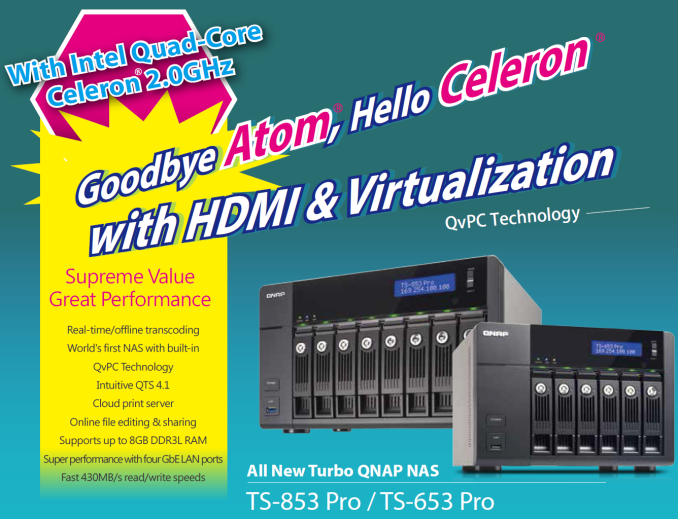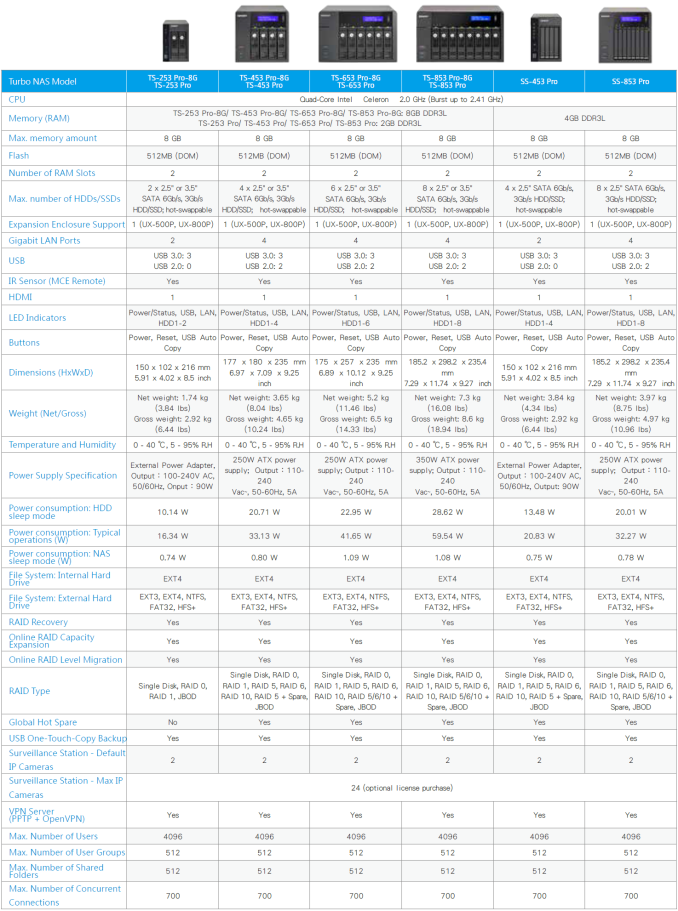QNAP Launches x53 Pro Bay Trail NAS for SMBs
by Ganesh T S on August 10, 2014 5:00 AM EST
The launch of the QNAP TS-x51 series was covered in great detail. QNAP took the lead over other NAS manufacturers in opting for the 22 nm Atom SoCs. While we were expecting the first Silvermont-based NAS units to use either Avoton or Rangeley, QNAP surprised us by opting for Bay Trail-D with the Celeron J1800. The advantage was that the Celeron J1800 included the Quick Sync engine, which enabled some nifty multimedia features targeting home consumers.
Fast forward a few weeks, and we have QNAP's play targeting business users using the same platform. The difference in the hardware relates to the choice of the Bay Trail-D part. Instead of the Celeron J1800 (which was a 2C/2T part), we have the Celeron J1900 (a 4C/4T part). While the 2-bay version comes with 2x GbE ports, the others come with 4x GbE ports. All the innovative features from the TS-x51 series (hardware transcoding and Virtualization Station, mainly) are present in the x53-Pro series too. Due to the availability of more resources, it is possible to run two VMs concurrently in the x53 Pro (compared to one in the x51). Since we have already touched upon the two main features in our x51 launch piece, we will not discuss them in detail here.
QNAP has bundled all the business-oriented features of the x53 Pro under the QvPC umbrella. QNAP projects using the x53 Pro NAS as a business PC in addition to fulfilling the tasks of a SMB networked storage device. The display is driven through the HDMI port and the interface is through the HD Station package (Hybrid Desk). Three 'views' are made available:
- QVM Desk: Users have a window into any of the VMs running on the unit.
- Defense Desk: Users can access the Surveillance Station UI for monitoring the IP cameras being recorded on the NAS
- Local Display Desk: Users have access to the X-Windows session on the NAS, enabling access to apps such as XBMC, Chrome, YouTube, Spotify etc. - all of which are specific apps for the NAS. Obviously, the NAS can be administered from within this UI also
The HD Station package also supports touchscreen monitors. Since Virtualization Station is supposed to soon support Android VMs, this is going to be a nifty feature.
Another SMB-targeted feature in QTS 4.1 is IT Management Station, based on Mandriva Pulse. It enables management of IT resources and applications for the whole business in a simplified manner. Tasks include inventory management, remote control, cloning, deployments and backup / restore.
The x53 Pro series (like the x51 series) also supports the UX-500P / UX-800P expansion towers. Using these, consumers can add 5 or 8 bays to their existing NAS by connecting via an USB 3.0 port. The various models in the x53 Pro series, along with their specifications, are provided below.
Interestingly, QNAP has two SS- models which support only 2.5" drives. It looks like the market for NAS units which support only 2.5" drives is slowly taking off. Earlier this year, we saw the introduction of Synology's DS414slim sporting a Marvell ARMADA 370 SoC. However, these are based on Bay Trail Celerons, and definitely much more powerful. With SSDs becoming cheaper by the day, all-flash arrays will soon be within the reach of even SMBs. Units such as the SS-453 Pro and SS-853 Pro are well-suited to tap into that market.











18 Comments
View All Comments
twistedgamez - Sunday, August 10, 2014 - link
more details in the pdf: http://inside.littlebit.ch/files/IN/Assets/Docs/DS..."The HybridDesk Station (HD Station) has an integrated XMBC media player, allowing you to directly enjoy multimedia files stored on a TS-x53 Pro/SS-x53 Pro using an HDMI-enabled display. With a QNAP remote control in hand, you can easily select what videos, photos, and music you would like to enjoy" - is seems really cool, a legitimate replacement for my (nuc)
imaheadcase - Sunday, August 10, 2014 - link
Very interesting indeed. Need some reviews to see if it is really worth it. But judging from reviews online Qnap systems not really great UI wise.My NUC does all the XBMC stuff, better than one of these, i will prob just get a synology simply for storage.
ganeshts - Sunday, August 10, 2014 - link
For the HTPC stuff, a dedicated box (NUC or a real HTPC) is always preferable - let the NAS do its job of serving content on storage over the network :)UI is improving slowly.. Pre-QTS 4.x, the interface was barely usable, but with the modern 'mobile app' layout, it has become better. That said, responsiveness of the UI is still an issue compared to some of the market leaders out there.
smitty123 - Sunday, August 10, 2014 - link
i'm still using v3.8.3 on my qnap and prefer it to the v4.0's desktop approach. i prefer the lists on the left side where i know where everything is and is of easy access.1 click i'm where i need to be.
Some prefer v4, some prefer v3, it's a matter of preference is all. Not less usable.
basroil - Sunday, August 10, 2014 - link
4 gigE ports? If they support 4x aggregation that's some massive speed. Not sure that it's worth it unless you have a caching SSD includedganeshts - Sunday, August 10, 2014 - link
Yes, 4x GbE aggregation is supported. (Synology already has it in their x13+ series).Note that these units can run two VMs concurrently - so, they each take up one GbE port. In the end, many users might end up with 2x GbE aggregation only. It all depends on the usage scenario.
QNAP supports SSD caching even in the x51 series (though I don't expect home users to take advantage of that).
bernstein - Sunday, August 10, 2014 - link
Can someone **please** enlighten me why *****all***** nas use legacy ext4 on mdadm and not zfs?? we had tons of boxes running this combo and switched allmost all to zfs (ubuntu) for increased stability (simply put: night-and-day) and thus maintainablity - with increased data protection as a secondary benefit...AlexAlex - Monday, August 11, 2014 - link
ext4 legacy? it seems like you are a bit confused about linux..Anyway, zfs is not mainline in linux kernel, This alone will suffice.
And zfs is not for mainstream, first of all you need ECC memory to run it as it should.
There are a whole lot of reason to let it out from the mainstream market.
Morawka - Sunday, August 10, 2014 - link
Any pricing details? wonder if the 4 bay is at all affordable for the enthusiast.Montago - Monday, August 11, 2014 - link
I really don't get why people still buy these crappy NAS boxes, instead of building one yourself..Or even buy a real server!!
I built a machine for the same cost as a 5bay QNAP/Synology, with room for 6 drives.. Core i5 4570 and 16 gb ram. I run 4 virtual windows 2008 and plex without any problems...
No dedicated nas can do that at the same price